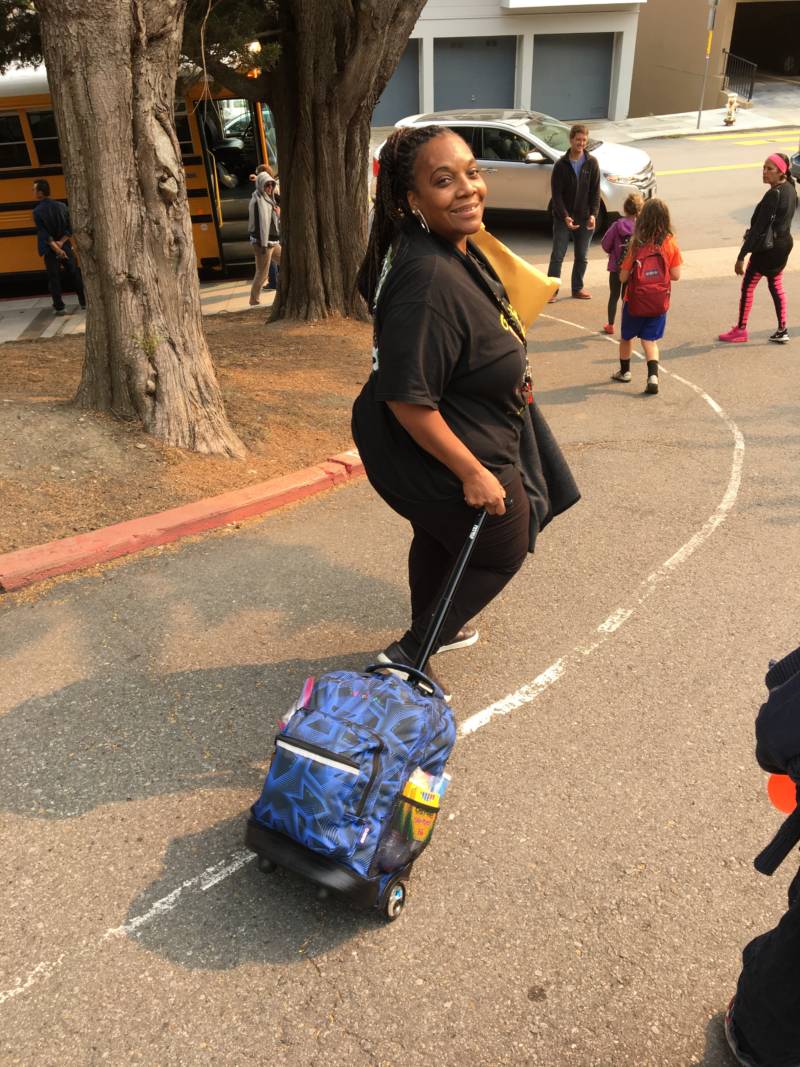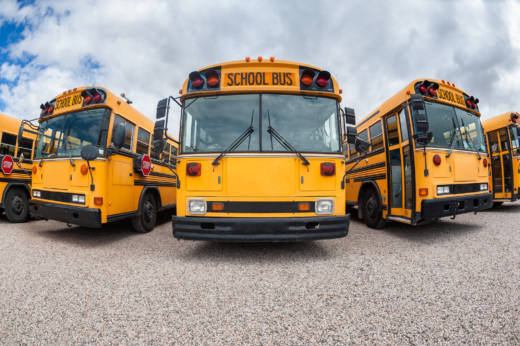Though her own children are long since grown, Sheila Hall rides alongside her “babies” on a yellow school bus for about an hour every weekday morning during the school year. In the afternoon she accompanies the group of primarily African-American and Latino kids for the return trip, while many of their classmates at Rooftop School in the San Francisco Unified School District stay behind for after-school activities like French, guitar and “Lego robotics.”
One of the biggest flaws with traditional school transportation, says Todd Ely, director of the Center for Local Government Research and Training at the University of Colorado Denver, is that 66-passenger buses must make several stops along an indirect path. That design translates to long swaths of time with energetic children managed in triage fashion. (“Never put a student off your bus” and “never use profanity” are two tips for drivers in a pamphlet from the American Federation of Teachers.)
Buses are also expensive to operate, which means most of the more than 25 million children in the U.S. who ride them are offered only one return trip: right after school. As a result, transportation-dependent kids like Hall’s babies miss out on a hidden curriculum of on-site after-school enrichment, as well as interpersonal engagement, like impromptu conversations with teachers. The status quo puts the rural students and low-income children in large urban districts who rack up the most bus minutes at a disadvantage compared to their peers who live within walking distance of school or whose parents have the time and money to drive.

Some are trying to change that with a variety of ride-sharing initiatives that decrease transit time, but long rides sometimes can’t be helped and even relatively short ones could be better managed. Ely says: “I always thought, just put Bill Nye the Science Guy on. You don’t want kids just watching TV, but … if it’s something that’s going to broaden exposure, it would be beneficial. At least the time isn’t lost time.” Districts have experimented with piping music onto buses, but Ely would prefer more, envisioning “interactive games where kids have clickers, and they’re actually responding to questions.”
It sounds fanciful, but one district has brought something along these lines to life. Over the last two years, Google piloted its Rolling Study Halls program, providing grants to help equip school buses with Wi-Fi and stripped-down laptops. Priscilla Calcutt, director of instructional technology for the Berkeley County School District in South Carolina, says the students who live in the more high-poverty areas of her district ride the bus for 90 to 120 minutes each direction. For them, “the Wi-Fi has been a great tool.” The district has filters in place that block certain websites and keywords on both the district-provided Chromebooks and kids’ handheld devices, “but they could play games if they wanted to on the bus on the way home,” Calcutt says. Or they can get a jump on the evening’s homework.
To incentivize enrichment over entertainment, Berkeley County instructional technologist Jessica Levine helped create “bus challenges” aligned with Achieve3000, a reading and writing instruction platform used by the district’s schools. Calcutt explains: “One of the bus challenges would be to read two articles from Achieve3000 and score 80 percent or higher on your quiz.” For tackling the extra work, students earn incentives such as badges, a dance or a pizza party. A virtual help desk, Levine says, allows kids to connect with teachers and ask questions about the challenges, or get help with other homework, all while in transit.
These innovations, aligned as they are with in-school work, function as a virtual analog of something academic research shows districts relying on busing often can’t adopt: extended learning programs such as longer school days. They also help level the playing field vis-a-vis children who have essentially cobbled that together by living close to school (they get after-school tutoring on site and hop on Achieve3000 from home, Calcutt says).
Though the district doesn’t have data directly tying the program to improved academic performance, Levine says teachers report the kids coming off the bus with “improved overall attitude” and bus drivers see less misbehavior “because students are engaged in doing something.” It’s enough to justify Google expanding the program.
During the 2016-17 school year, Berkeley County even had teachers on the bus giving coding lessons thanks to a grant awarded to the College of Charleston, but Calcutt says the model wasn’t sustainable, both financially (once the grant money ran out) and due to other demands on teachers’ time (their training often takes place after school, and even when that’s not an issue, riding four hours round trip after teaching a full day is a tall order).
On the other side of the country, Rooftop’s on-site after-school program director, Leslie Einhorn, sees an easy solution to that logistical hurdle: putting someone who doesn’t teach at the school on the bus. The instructor could work in conjunction with high-tech solutions or go analog, she says, getting the kids involved in something like singing. But she and parent advocates haven’t been able to arrange evening bus service to try it out. In a 2014 grant application, Einhorn tried to work around that hurdle, proposing what she calls “escorted transportation” where her instructors would ride public transit with students, spending the hour-plus commute facilitating conversations that boost social-emotional development.
The school’s principal decided not to wait for any of these big ideas to materialize. In her first semester on the job, Nancy Bui five times rode the bus that delivers students from the Bayview neighborhood up into the hills where her school is nestled, the same one that bus monitor Sheila Hall boards. Bui and her vice principal observed not just what one would expect—that incendiary pairing: boredom and energy—but also anxiety. Second-grade teacher Nicole Wickstrom agrees, describing students having arrived at her classroom in the morning “often in a state of fight-or-flight or heightened emotions.”
On a shoestring budget and with the help of the school’s art coordinators, Bui launched a program dubbed #FirstClass that distributes kits filled with supplies like markers, modeling clay, connect-the-dots, origami and whiteboards. Hall brings extras along in a rolling backpack, “like a stewardess, only for enrichment materials instead of drinks,” Bui jokes before adding, “though Ms. Sheila is so much more than that.” The school’s literacy specialist got involved, too, ensuring that vocabulary words included on cards in the kits serve students’ individual needs.
“It’s boring; it’s bumpy,” Bui says: “Traffic happens. Things happen.” Four times during the 2017-18 school year the bus was involved in an accident. The first occurred before the #FirstClass rollout, and Bui calls it “a disaster.” But after a subsequent fender bender, she says: “The police were shocked. They were like, ‘They’re so happy!’” Wickstrom echoes the qualitative conclusions of her teacher counterparts in South Carolina, saying engaging in something meaningful on the bus “can allow them to come to school ready to learn.”
As promising as these small programs are, Professor Ely hasn’t heard anyone else “talking about how to make that time more constructive.” He says: “I don’t think that’s out there. It’s still a logistics field where if you talk to transportation people, it’s all time and distance for them. They’re not educators.”
Yet high-quality, in-transit enrichment—in conjunction with programs that decrease ride times—could address a problem that has plagued integration efforts for more than half a century: how to keep the burden of transportation from falling solely on the backs of brown-skinned and low-income children. Decreasing the level of strain is a step in the right direction, Ely says. There’s a second theory—that the more appealing busing can be made, the more likely wealthier families are to use it—but Pedro Noguera, director of the Center for the Transformation of Schools at UCLA’s Graduate School of Education and Information Studies, is skeptical.
“I like the idea of using travel time to educate or sing,” he says, but knowing what he does about racial bias and fear, he isn’t “sure if anything will make the bus attractive to the white middle class, unless it was to attend school with white elites.” The kids who currently ride buses need programs to ensure bus time isn’t wasted time, Noguera concludes, but they deserve far more.
Gail Cornwall is a former public school teacher and lawyer whose children attend Rooftop Elementary School in San Francisco.


